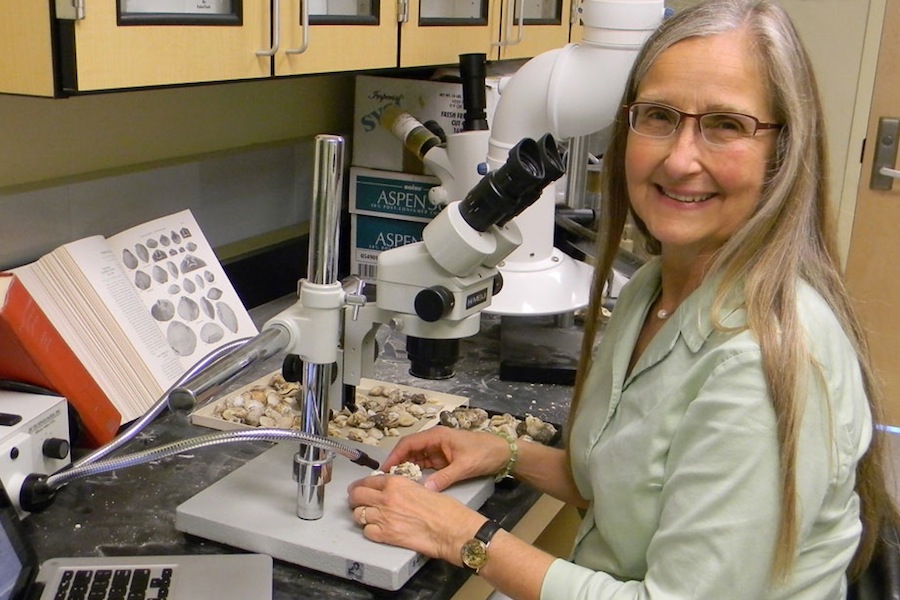
Department of Earth and Planetary Sciences’ vast array of research extends from ocean depths to other planets
For many, the first thought that comes to mind when hearing the word “paleontology” is dinosaur bones. But what about paleobiology? The Department of Earth and Planetary Sciences at UC Davis houses world-class paleobiologists researching marine organisms like photosynthetic bacteria and brachiopods, vertebrae fossils and even microorganisms that may have once lived on Mars.
Paleobiology is the study of early life and the history of Earth that utilizes tools from geology, paleontology and biology alike. Understanding biological and environmental history is key to studying fossils because it may explain why a certain organism went extinct.
Sandra J. Carlson, professor of the Department of Earth and Planetary Sciences and UC Davis faculty member of 30 years, is one of the few paleobiologists that studies brachiopods. Brachiopods are marine organisms that have a similar appearance to clams, and tend to live in deep, cold water near the equator or poles.
“Brachiopods today are living, but 95 percent of them are extinct […] I look at how the living brachiopods can give us information of the past,” Carlson said.
Much of the brachiopod research investigates how these previously abundant organisms changed in morphology, or physical appearance, as well as what factors contributed to their extinction.
“We don’t eat [brachiopods], nor are they diverse, but it is important to study them because they give us information on atmospheric and ocean health,” Carlson said.
Carlson has published groundbreaking research on the evolution of brachiopods, and received the 2016 Encourage Award by the Association for Women Geoscientists (AWG).
Serving as the president of the Paleontology Society (PS) from 2012 to 2014, and later returning as a council member, Carlson has strengthened the partnership between the PS and AWG to encourage women in the field of paleontology and support paleobiology students throughout their academic careers.
Carlson’s hard work also includes creating scholarship awards for undergraduate, graduate and masters students, as well as early-career researchers. In addition, Carlson helped to double the value of each scholarship.
The number of applications for these scholarships increases every year, and they have supported a number of determined young women pursuing paleontology.
Another researcher in the Department of Earth and Planetary Sciences is professor Ryosuke Motani, whose focus is studying vertebrate organisms, specifically Mesozoic marine reptiles.
“We are trying to figure out how the evolution of vertebrate animals in the past were driven or restricted based on certain factors, like the type of environment during that time,” Motani said.
Previous field work has taken Motani to China, where he excavated fossils from the marine Triassic of South and Southwest China. His current research involves studying the physics-based functional morphology driving the evolution of animal shapes during the worst mass extinction 251 million years ago.
Another focus of paleobiology research involves understanding the origin of oxygenic photosynthesis on Earth. Dawn Sumner, professor of Earth and Planetary Sciences, collaborates with the University of Canterbury, New Zealand, the Natural History Museum of London and the Massachusetts Institute of Technology to discover new characteristics of photosynthetic bacteria.
“Right now I am working with bacteria that grow in lakes in Antarctica that are photosynthetic during the summer but not during the long, dark winters,” Sumner said.
Sumner and her team analyze the evolutionary relationships between these bacteria and similar organisms in order to explain how oxygenic photosynthesis evolved. Such research can benefit climatologists and geologists, since the appearance of oxygen in the Earth’s atmosphere has drastically affected Earth’s ocean acidity, atmosphere and potential for life over time.
Sumner’s experience with understanding early life on Earth made her an excellent candidate for a NASA committee seeking evidence of life on Mars.
“[We had to ask] how do you look for life on another planet when it might not exist? How do you make that search useful scientifically even if life never existed on Mars?” Sumner said.
The committee sent the Curiosity Rover to a location on Mars where there may once have been liquid water. The goal was to analyze the sediments there and see if the environment could have harbored life similar to life on Earth.
“We have found evidence [of] ancient lakes and rivers that were once capable of supporting life similar to some bacteria on Earth,” Sumner said. “We do not have any evidence that life was actually present; we have not found any fossils.”
Exploring Mars with a robot gave scientists ground images that couldn’t have been seen before. Although the robot has limitations when it comes to data collection, the results are highly valuable.
“Results also show that the surface of Earth and Mars were likely similar when both planets were young, 4.6 to 3 billion years ago,” Sumner said.
Mars is very different than Earth and is extremely cold, so it is unlikely that life could persist, at least near the surface.
Many labs on campus offer undergraduate students opportunities to pursue research in paleobiology. The Department of Earth and Planetary Sciences website lists professors and research groups currently working on projects.
“[Paleobiology is] something you can pursue for the rest of your life if you are really interested,” Motani said.
Written by: Shivani Kamal — science@theaggie.org



